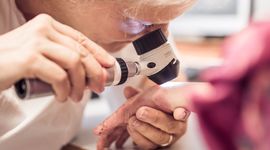The disease
The human skin consists of several layers. The epidermis is the outer most layer, which is the "outer skin". "Bullosa" means "bubble-shaped" and "Lysis" solution. Therefore Epidermolysis bullosa is literally called "bubble-like detachment of the epidermis".
Epidermolysis bullosa is not the name for a single skin disease, but a large group of clinically and genetically different diseases. Their common feature is the formation of blisters. Blisters form from low mechanical stress on the skin and/or mucous membranes. There are a number of sub-types of Epidermolysis bullosa, that differ due to the skin layer in which the blisters are formed and what exactly the genetic cause is. These types come with some additional features and problems.
Important points in a nutshell
- In all types of EB the skin forms blisters after a low mechanical stress.
- Due to genetic changes in each individual type of EB a building block for the anchoring of the skin layers with each other is missing or is not fully established.
- The various forms of EB can be distinguished by:
- the skin layer in which the blisters are formed
- the missing protein molecule
- the exact location of the genetic modification
- the severity
- additional problems also caused by the lack of the molecules.
- Even with similar-sounding name the forms of EB can be completely different!



